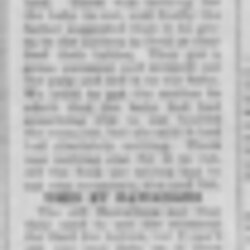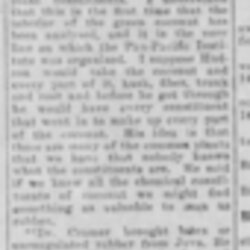Coconut Milk May Play Important Role in Feeding Of Infants
"The pulp of the young coconut contains all of the constituents of the human mother's milk, and perhaps in the tropics it may be made to take the place of the mother," was the statement made at the second weekly gathering of the Pan-Pacific Science council Friday night at the Army and Navy "Y."
The announcement was made by Dr. N. P. Larsen of the Queen's hospital, the first to secure exact knowledge as to the chemical constituents of the milk and pulp of the young coconut. It developed during the meeting that there were Hawaiians present who had been weaned on coconut pulp and milk, but it is believed that the announcement to the council is the first to be made of the actual chemical constituents of the pulp milk of the coconut.
Alexander Hume Ford, director of the Pan-Pacific Union, introduced Dr. Larsen, stating that he had spent an hour with him comparing notes on the possibility of using a combination of coconut and water buffalo milk as the ideal and perfect milk for infants. He stated that he had asked Dr. Larsen to tell the scientists the story he had told him over a pile of young [coconuts] in the doctor's laboratory at the hospital.
ADVISES CAUTION
Dr. Larsen said:
Mr. Ford is most enthusiastic, and sometimes perhaps the automobile gets away off into space when it should be back on the [page 2] road. Of course, I am glad for his preliminary statement, but as a medical man and one interested in science, I feel all statements should be made with caution and wait to be proven.
There is a germ in this idea, but the interesting thing that Mr. Ford brought up was the idea of [cooperation]. During the war we realized the value of [cooperation] so well. Men had been working scientifically for years, but unfortunately scientists along with other lines were all dumb-bells. Each one in his work thought he was the only one that had the right way, and each worked for himself. When the war came this was changed. They would get the best scientists for one purpose and the best for another, and say: Gentlemen, here is the problem. Here is your part, and here is your part. Work it out.
ALL HELPS
The idea of progress is good and I think the idea of research is good, and naturally with the combined efforts of many the results are better. Of course, it is perhaps better for the individual man to work alone, because the individual man is working for the future glory of a Pasteur. But we each have to be satisfied with doing our little bit, and if our little bit helps the little bit of others, I feel that we should be satisfied as scientists.
Some time ago we had a baby brought to the hospital. It was a perfect specimen, fifteen months old, had teeth, could walk and was a nice specimen. This baby was brought here from Fanning Island, where the dress is made from coconut fiber and the houses are on stilts. Once in a long time, say once in six months or sometimes once in a year, a boat stops there. There are about twenty natives and ten whites living there on an eighteen-mile circle of coral. When the whites want to go swimming the natives form a circle around them to keep the sharks away, as sharks will not touch brown bodies.
This baby was brought up from New Zealand, where it was born. It was an incubator baby. Both parents were on board and they were so ill that they could not be taken on so were dumped off at Fanning Island. There was nothing for the baby to eat, and finally the father suggested that it be given to the natives to feed as they feed their babies. They got a green [coconut] and scraped out the pulp and fed it to the baby. We tried to get the mother to admit that the baby had had something else to eat besides the [coconut], but she said it had had absolutely nothing. There was nothing else for it to eat. All the food the whites had to eat was [coconuts], rice and fish.
USED BY HAWAIIANS
The old Hawaiians say that they used to use the [coconut] for food for babies, but I can't get any real data on it from them.
(Here Fred Beckly spoke up and said he had been weaned and brought up on [coconut] pulp and milk.)
You can't bring a child up on [coconut] water alone, but have to have the [coconut] pulp. Here we have a gentleman that looks well and strong for having been raised on [coconuts].
Then, through the kindness of Mr. Warner, who made the analysis for us, we are able to find out what ingredients the [coconut] contained. We had the pulp and that is just what the mother had been giving the child, and we [analyzed] it. Much to my surprise it did contain all the ingredients that were necessary. It was surprising how it compared with mother's milk. It had all the elements. If it has all these elements, then it should develop a child. Another thing that is interesting is that the [coconut] pulp contains about three [percent] sugar. Mother's milk contains about four [percent] -- from four to seven -- but we find that the [coconut] water contains a little over five [percent]. In questioning the mother we found that she fed the baby [coconut] pulp and in between times, as there was no water for the baby to drink, she fed it [coconut] water. This brought up the sugar content to mother's milk. The protein content is a little low, but perhaps the child didn't need that. We found also that the fat content was low. There are various theories on how much fat a baby needs in milk. Here we had a child that undoubtedly was brought up on low fats.
But the thing that Mr. Ford wanted me to state, I was a little hesitant about, because I feel we do not know definitely yet. I am glad he brought in some more evidence.
ARE NOW WASTED
Here we have a city where I think perhaps every one of us has [coconut] trees in the yard. We are wasting them. I have thrown away any number. We can use some for cake, give some away, etc., but we can't use the number that are here, and we have babies who actually need milk. This [coconut] water is absolutely sterile. We have had tests made of it. There is no question that babies can take it, no question that it is sterile, [illegible] no question that it is nourishing. If we need the help and advice of the botanists or any other of the scientists who are here, let them come forward and add a few kernels of truth.
After we have tried this out a few months on babies that cannot take milk -- tried these [page 3] babies on [coconut] pulp and water, then we have found something new. And if this is true, we can perhaps make a useful thing out of something which here in the islands we have wasted year out and year in.
One other thing Mr. Ford brought us. When I was telling him about this food that had all the ingredients that could feed a baby but was low in fat, he said that the water buffalo milk has lots of fat. There then is a milk that we could develop with fifteen [percent] fat, dilute it with [coconut] milk, and we have a good food. Another thing -- the water buffalo is immune from tuberculosis. We have got then the water buffalo fat in milk that cannot contain tuberculosis germs, and we have a [coconut] milk that is pure and combining the two we have a food that is perfect, and we produce the Pan-Pacific race, which is greater than any other race.
In concluding Mr. Ford said: "Dr. Larson's work is exactly along the line of research for which the Pan-Pacific Research Institute is being established. That institution was the idea of Dr. C. S. Hudson of the Bureau of Standards, a research chemist who is, we hope, to head the department for the study of plant constituents in the Pan-Pacific Research Institution.
ORIGIN OF IDEA
The idea of the Pan-Pacific Research Institute originated here while I was in Washington. Word was sent me there by H. P. Agee.
"Mr. Hudson wanted this Institute established so he could have a department there on the study of plant constituents. I understand that this is the first time that the interior of the green coconut has been [analyzed], and it is the very line on which the Pan-Pacific Institute was organized. I suppose Hudson would take the coconut and every part of it, husk, fiber, trunk and root and before he got through he would have every constituent that went in to make up every part of the coconut. His idea is that there are many of the common plants that we have that nobody knows what the constituents are. He said if we knew all the chemical constituents of coconut we might find something as valuable to man as rubber.
"Dr. Cramer brought latex or uncoagulated rubber from Java. He said you could dip eggs in that and they would come out coated with rubber and be impervious to air. He also dipped part of a banana in this rubber and that part was perfectly preserved while the rest rotted. This was done with the alligator pear, and it was preserved for months.
"When I went in Doctor Larsen's office the first thing I noticed was the pile of coconuts. That is why I want to see in these scientific talks the visual end of it straightened. I would like to see the coconut hanging from the wall, the whole coconut, a half one and in all possible ways the use of the milk visualized; I would like to see Mr. Beckley there, and that infant, and other interesting demonstrations that would catch and hold the intellect of all of us, and especially these young people.
"What I said about the water buffalo is true. They have done everything possible to give it tuberculosis, but it is simply immune. The water buffalo gives only five quarts of milk a day, but in cream this is equal to fifteen quarts from a cow. Dr. Krauss is backing me up. He says it does give fifteen [percent] cream.
"Fortunately for every one, I am not a scientist, therefore they have no secrets to hide from me. They don't think I know enough to be dangerous. I can tell them what each other is doing and the first thing I know I am commissioned as an emissary to bring about some form of [cooperative] effort, and that is what the Pan-Pacific Union is for. I earnestly hope that at each of our Friday night sessions some useful scientific discovery may be announced. Why not?"













Comments